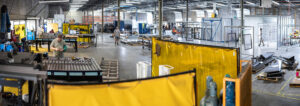
In the fast-paced world of manufacturing every step is crucial. Let’s explore the basic assembly process and all the steps involved.
Component Preparation: Organizing and Inspecting Components
Before assembly can begin, you will need to be sure that you have all of the necessary components organized and thoroughly inspected to minimize the risk of errors and delays.
As you organize and set everything up, it’s important to remember components should be sorted and stored systematically so that they’re easily accessible for the assembly line workers. Inspection and quality control measures at this initial stage are vital to help ensure the integrity of the final product.
Assembly Line Setup Optimization of Workflow
In order to maximize efficiency and productivity manufacturers frequently use meticulously designed assembly lines. Each station on the assembly line is strategically arranged taking into account factors such as component accessibility, ergonomic considerations for workers, and the flow of materials. This type of setup creates a seamless transition from one step to the next, helping to prevent potential bottlenecks and delays. By eliminating unnecessary movements and optimizing workflow, manufacturers can significantly increase productivity and reduce costs.
Assembly Steps: A Sequential Approach
The assembly process typically follows a sequential order to maintain accuracy and consistency. While specific steps may vary, some common steps in this process include:
- Component alignment: grouping identical and similar components together
- Fastening or connecting various components together
- Integrating electronic components or mechanical systems into the product
Skilled assembly line workers follow detailed obstructions and use specialized tools to perform every step correctly. Following a well-defined sequence of steps allows manufacturers to precisely produce high-quality products designed to meet or exceed what the customer expects.
Quality Assurance: Inspections and Detecting Defects
Inspections performed during and after the assembly process is complete, assure quality and guarantee the finished product will meet the required standards and specifications. These help manufacturers maintain the highest standards of quality and reduce the likelihood of defective products reaching the market.
Packaging and Shipping
After being fully assembled and passing all of the needed quality control inspections, products are securely packaged to ensure they’re protected throughout transportation. They’re also properly labeled so they can be tracked and delivered in a timely fashion. Following a well-prepared package and shipping process allows a manufacturer to increase customer satisfaction and maintain a competitive edge in the market.
Following the Process
The basic assembly process in manufacturing involves carefully preparing all of the components, setting up the assembly line for maximum efficiency, following sequential assembly steps, conducting quality assurance tests, and then painstakingly packaging and shipping the product. Adhering to these essential steps makes it possible for manufacturers to ensure the production of high-quality products that meet or exceed customer demands.
If you want to work with a partner who is an expert in the assembly process, get in touch with EDCO Fabrication!
